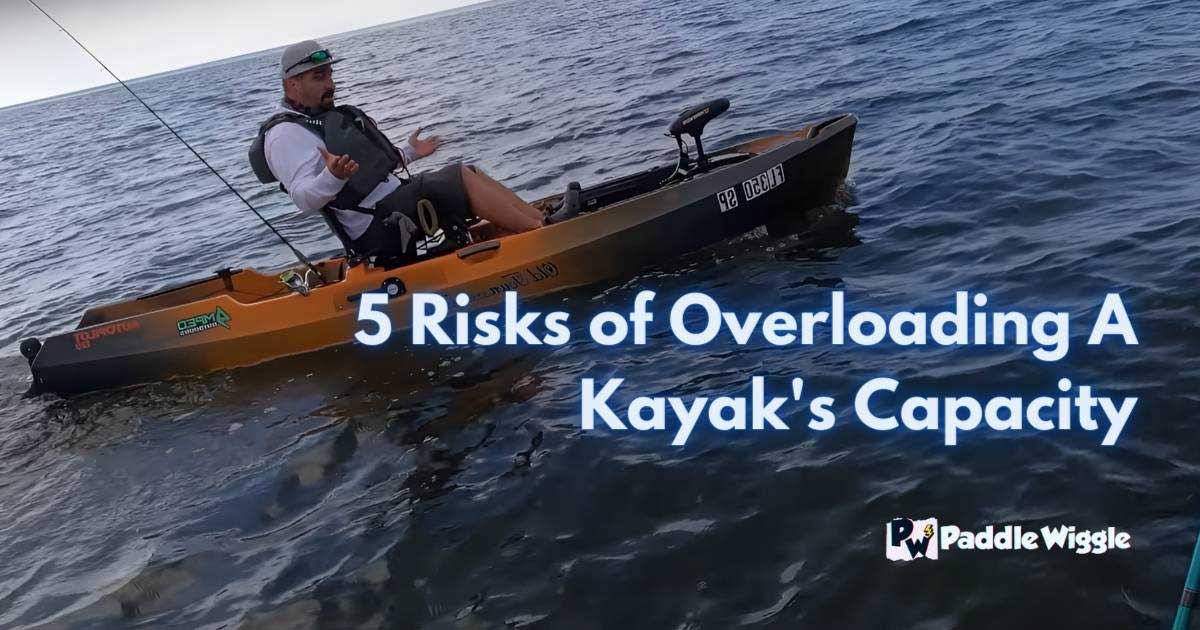Are you excited about venturing out into the waters with a kayak? Well, before you set sail, it’s important to understand the concept of a kayak’s weight limit. Don’t worry, though – we’ve got you covered!
Kayaks come in various types, and each has its own weight limit and capacity, determining the maximum amount of weight it can safely carry.
So, let’s start with why the weight limit matters.
Contents


Why is it important to consider the weight limit of a kayak?
Considering the weight limit of a kayak is incredibly important for a variety of reasons. When you go kayaking, it’s not just about hopping into a boat and paddling away. You need to ensure that you and your equipment are within the recommended weight capacity of the kayak.
Let’s dive into why this matters.
Firstly, the weight limit of a kayak directly affects its stability and maneuverability. Imagine you’re trying to balance on a narrow beam. If you’re carrying a heavy backpack, maintaining your balance becomes much more difficult. Similarly, if a kayak is overloaded with too much weight, it becomes unstable in the water and can easily tip over, leading to an unexpected swim.
Secondly, exceeding the weight limit stresses the kayak’s structure unnecessarily. Just like any other piece of equipment, kayaks have their limits. When you exceed the capacity, the kayak’s hull may become strained, increasing the risk of cracks, leaks, or a complete failure. It’s like trying to carry a massive load in a backpack not designed to handle it – eventually, the straps may snap.
Let’s imagine this scenario:
You and your friend went out on a kayaking trip! You were so excited that you didn’t pay attention to something really important – the weight limit of the kayak. And you didn’t know how a kayak’s capacity can affect the overall performance.


As you started paddling, you quickly noticed that the kayak felt wobbly, making you a bit nervous. You didn’t think too much about it, thinking it would be alright. But then, out of nowhere, a strong gust of wind blew across the water and pushed against the overloaded kayak. Uh-oh!
Because the kayak already had too much weight, it struggled to stay steady. And guess what happened next? The kayak flipped over, and you and your friend splashed into the water! It was a surprising and unexpected turn of events.
Mistakes happen, right? But the situation could have been avoided by considering the weight limit and distributing the weight properly.
How to Calculate the Actual Weight Capacity of a Kayak
Calculating a kayak’s actual weight capacity might seem tricky, but with a little guidance, you’ll be able to do it easily!
Remember, the weight capacity is the total weight the kayak can handle, including the weight of the people and any gear or equipment you bring.
Let’s break it down into easy steps so you can do it like a pro!
Calculating a kayak’s capacity is not rocket science! You can simply do this in a few seconds.
Here’s how you can calculate the actual capacity of a kayak:
Step 1: Find the manufacturer’s specified weight limit
Step 2: Know the weight of the kayak
Step 3: Subtract the weight of the kayak from the capacity
Less than 3 minutes
Find The Manufacturer’s Specified Weight Limit
Every kayak comes with a manufacturer’s specified weight limit. This is the maximum weight that the kayak can safely carry. Look for this information in the kayak’s manual, on its label, or on the manufacturer’s website. It’s an important number to know!
Know The Weight Of The Kayak
The weight capacity of a kayak refers to the total weight it can carry, including the weight of the kayak itself. So, you need to find out how much the kayak weighs. This information can also be found in the manual or on the manufacturer’s website.
Subtract The Weight Of The Kayak From The Capacity
To calculate the actual weight capacity, subtract the weight of the kayak from the manufacturer’s weight limit. For example, if the weight limit is 300 pounds and the kayak itself weighs 50 pounds, the actual weight capacity would be 250 pounds (300 – 50 = 250).
kayak weight limit With Capacity Chart
When it comes to kayaking, it’s important to know the weight limits of different types of kayaks. Each kayak is designed to carry a specific weight to ensure your safety and enjoyment on the water.
Let’s explore the weight limits of various kayak types:
| Kayak Type | Weight Limit / Capacity |
|---|---|
| Tandem Kayak | 400-600 pounds |
| Single Kayak | 250-400 pounds |
| Fishing Kayak | 350-550 pounds |
| Sit-On-Top Kayak | 250-450 pounds |
| Sit-Inside Kayak | 250-450 pounds |
| Touring Kayak | 350-600 pounds |
Tandem Kayak Capacity
A tandem kayak is designed to carry two people. It has a higher weight limit compared to a single kayak because it needs to support the weight of two individuals. On average, the weight limit for a tandem kayak ranges from 400 to 600 pounds. This means paddlers and any gear they bring should not exceed this weight limit.
Weight Limit Of A Single Kayak
A single kayak is designed for solo paddlers. It has a slightly lower weight limit compared to a tandem kayak since it only needs to accommodate one person. The weight limit for a single kayak usually ranges from 250 to 400 pounds. It’s important to remember that this includes the paddler’s weight and any additional items they bring on the kayak.
The capacity of Fishing Kayaks
Fishing kayaks are specially designed with features for anglers. These kayaks typically have a higher weight limit to accommodate the weight of fishing gear and equipment. On average, fishing kayaks have a weight limit ranging from 350 to 550 pounds. This allows anglers to bring their fishing gear, coolers, and other essentials while maintaining stability on the water.
Weight Limit Of Sit-On-Top Kayaks
Sit-on-top kayaks are popular for their easy entry and exit. They have an open-top design and a weight limit suitable for different activities. On average, sit-on-top kayaks have a weight limit ranging from 250 to 450 pounds. This weight limit accounts for the paddler’s weight and any additional items or accessories they may have on the kayak.
Sit-Inside Kayak’s Capacity
Sit-inside kayaks provide a more enclosed and traditional paddling experience. These kayaks typically have a weight limit similar to sit-on-top kayaks, ranging from 250 to 450 pounds. The weight limit ensures that the paddler and their belongings can be comfortably accommodated while maintaining stability and maneuverability on the water.
Touring Kayak’s Weight Limit
Touring kayaks are designed for longer trips and expeditions. They are built to handle various conditions and have a higher weight limit to accommodate the necessary gear and supplies for extended adventures. The weight limit for touring kayaks can range from 350 to 600 pounds, allowing paddlers to carry camping gear, food, and water for their journeys.
Factors Affecting Kayak Capacity
There are several factors that can affect the capacity or weight limit of a kayak. Understanding these factors is essential for choosing the right kayak and staying safe on the water.
Let’s explore these factors.
Size and Design


The size and shape of a kayak are important. Big kayaks that are longer and wider can hold more weight. They have more space and float better in the water, so they can handle extra weight. On the other hand, smaller kayaks might have a lower weight limit because they have less room and don’t float as well.
Material and Construction
What a kayak is made of also matters. Some kayaks are made from plastic, fiberglass, or carbon fiber. The materials used can affect how strong and buoyant the kayak is. Kayaks made from strong, lightweight materials can handle more weight than those made from heavier or less strong materials.
Type of Kayak
Different kayaks are made for different things. There are kayaks for two people, fishing kayaks, and touring kayaks, just to name a few. Each type of kayak is designed for specific activities and has different weight limits. For example, fishing kayaks have higher weight limits because they need to carry fishing gear while touring kayaks can carry camping supplies for longer trips.
Weight Distribution
How weight is spread out in the kayak is important too. Putting the weight evenly between the paddler(s) and any gear is best. If the weight is lopsided, the kayak can become unstable and tip over easily. Keeping the weight balanced helps the kayak stay steady and use its weight capacity effectively.
Water Conditions


The water you’re kayaking in also plays a role. If the water is choppy with waves or strong currents, following the weight limits is important. These conditions require more stability, and going over the weight limit can make it harder to control the kayak.
5 Risks of Overloading A Kayak’s Capacity


Overloading a kayak, which means putting too much weight on it, can be risky and potentially dangerous. Let’s explore the risks of overloading a kayak’s capacity:
Instability and Tipping Over
When a kayak is overloaded, it becomes less stable in the water. It may feel wobbly and unsteady, making it easier to tip over. This is because the weight is not properly balanced, and the kayak struggles to stay upright. If the kayak flips over, you and your belongings could end up in the water, which can be scary and unsafe.
Difficulty in Maneuvering


An overloaded kayak is harder to maneuver and control. It may become sluggish and unresponsive, making paddling and steering challenging. This can be problematic, especially if you need to navigate around obstacles or in areas with strong currents. Difficulty in maneuvering increases the risk of accidents or collisions with other objects in the water.
Decreased Buoyancy and Floating Ability
A kayak has a certain level of buoyancy, which allows it to float on the water. The kayak’s ability to float properly is reduced when it is overloaded. This means that it sits lower in the water and can be more easily swamped or filled with water. A kayak not floating properly is at a higher risk of capsizing or sinking, putting you in danger.
Slower Response to Emergency Situations
In the event of an emergency or unexpected situation, an overloaded kayak may not respond as quickly as it should. The extra weight can slow down the kayak’s movements and make it harder to react in time. This can be critical when quick maneuvering or rapid responses are necessary for safety.
Fatigue and Strain on the Paddler
When a kayak is overloaded, it can put extra strain on the paddler. Paddling becomes more difficult and requires more effort, leading to quicker fatigue. This can impact your ability to enjoy the kayaking experience and may increase the risk of muscle fatigue or injuries.
Tips for Staying Within the Kayak Weight Limit
Staying within the kayak’s weight limit is crucial for your safety and the performance of the kayak. Here are a few tips to help you reduce the weight load and stay within the limit.
Pack Only the Essentials
Pack only what you need when getting ready for your kayaking adventure. Think about the items that are necessary for your trip and leave behind anything extra. This way, you can keep the weight down and stay within the kayak’s limit.
Use Dry Bags or Waterproof Cases
Invest in dry bags or waterproof cases to protect your gear from water while minimizing weight. These bags will keep your belongings dry and secure, allowing you to bring essential items without worrying about water damage. Plus, they are usually lightweight and easy to carry.
Distribute the Load Wisely
If you’re kayaking with a friend or family member, try to distribute the weight evenly. Share the gear, supplies, and any heavy items so that no one’s kayak is overloaded. It’s important to balance and ensure everyone stays safe on the water.
Leave Heavy Objects Behind
Avoid bringing heavy objects that are not essential for your kayaking trip. Items like large coolers filled with ice or heavy water containers can quickly add up to the weight. Instead, opt for lighter alternatives or plan to get supplies along the way if needed.
Check Your Gear Beforehand
Before heading out on the water, take a moment to weigh your gear and equipment. Ensure you know how much weight you’re adding to the kayak. This way, you can make any necessary adjustments or decisions about what to bring or leave behind.
Increase the weight capacity for necessary stuff
Kayaking is a fun water sport where people explore nature, enjoy beautiful views, and have a great time. But sometimes, kayakers face a challenge because their kayak can’t carry all the necessary stuff. That’s it’s crucial to know if it is possible to increase the capacity of a kayak.
Luckily, there are a few tricks that can help increase the weight capacity of a kayak. Here’s how you can do it:
Add buoyancy or float bags
You can increase your kayak’s weight capacity by adding inflatable bags called buoyancy or float bags. These bags are made of strong materials, and you put them inside the compartments of your kayak. When you inflate these bags, they create extra buoyancy, which means your kayak can carry more weight without tipping over. This is especially useful if you have heavy gear or if you’re going on a long trip.
Use stabilizers
Stabilizers are special attachments that you can put on the sides of your kayak to make it more stable. They work like extra support, kind of like training wheels on a bicycle. Stabilizers help prevent your kayak from tipping over, especially when you have a lot of weight in it. They are helpful if you’re carrying a big load or want extra stability for activities like fishing or taking pictures. Stabilizers can make you feel more confident and safe on the water.
Learn More
Do Kayaks Have Weight Limits?
Yes, kayaks have weight limits. Every type of kayak can only carry a certain amount of weight without any issues. The manufacturer sets this weight limit to make sure the kayak stays stable and works well. And exceeding the limit can lead to several risks, such as reduced maneuverability, decreased stability, and potentially even capsizing.
How Accurate Is The Weight Capacity On Kayaks?
The weight capacity listed for kayaks is usually right and important to follow. Manufacturers test their kayaks to figure out how much weight they can handle without any issues. They consider things like the size of the kayak, its shape, and what it’s made of.
Can You Increase The Weight Capacity Of Your Kayak?
Yes, you can increase the weight capacity of your kayak. In fact, there are several ways to do this. Some easiest ways include adding float bags and using a stabilizer. And it’s always a good idea to choose lightweight gear. This will reduce the chance of overloading it.
Final Word
Understanding a kayak’s weight limits and capacity is important for a safe and enjoyable kayaking experience. Because if you put too much weight in the kayak, it can become unstable and hard to control. It might even tip over, which can be dangerous, especially if you’re in deep water or far from shore.
Every kayak has a weight limit, which the manufacturer sets. It is mainly based on the kayak’s design and materials.
If you have a lot of gear or are close to the weight limit, you should consider packing lighter or maybe even look for a kayak with a higher weight limit.



